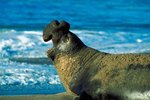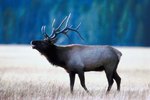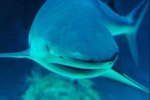
Sea lions, with their unmistakably noisy quirks, are sure to get the attention of passersby. If you're ever lucky enough to catch a glimpse of a sea lion, he may be basking in the sun while enjoying a snooze, or he might be barking, letting his voice be heard. Sea lions are considered pinnipeds, which translates to "fin footed" in Latin. They boast long whiskers and small ear flaps, which differentiate them from seals.
Social Butterflies
Sea lions are quite the social party animals, as they are rarely found alone. In fact, they live much of their lives in large groups. Sometimes these groups may number in the thousands, but there are smaller sub-colonies of sea lions within the larger colony or pod. Sea lions enjoy the closeness of living together -- even if they have plenty of room to spread out further from one another. Female sea lions are referred to as cows, while male sea lions are known as bulls. Their little ones are called pups.
Diving Skills
Sea lions are quite the skilled divers, with the ability to go underwater and stay underwater for as long as 40 minutes at a time. To do this, sea lions will close their nostrils together tightly, keeping them closed until they reach the surface again. During their underwater hunting sprees, they may go as far as 600 feet underwater. Natural-born swimmers, sea lions swim swiftly through ocean waters at speeds of up to 25 miles per hour.
Sea Lion Pups
Sea lion pups are born weighing in at around 13 to 15 pounds of absolute cuteness. Female sea lions carry their young for 12 months before giving birth, which usually takes place between May and July. Many sea lion pups will nurse from their mothers for four to eight months, although some sea lions may decide to stay close to Mom for longer. Pups know their mother's distinctive bark and can pick it out among all the other noisy, barking sea lions in the group.
Whiskers and Flippers
A sea lion might be lost without his whiskers. A sea lion's whiskers, called vibrissas, help sea lions navigate through ocean waters. Each vibrissa has the ability to rotate, much like a straw inside a bottle. The ultra-sensitive vibrissas help sea lions sense any potential food floating near. Their front flippers are very strong and can help them get around on land. Flippers also act much like a built-in heating and cooling system for sea lions. When it's cold, blood vessels in flippers constrict and prevent heat from escaping. When it's hot outside, blood circulates to the flippers to help the sea lion cool down.
References
Photo Credits
-
John Foxx/Stockbyte/Getty Images
Writer Bio
Pamela Miller has been writing for health, beauty and animal health/welfare publications for seven years. Miller holds a Bachelor of Science in Organizational Communication from MTSU.




